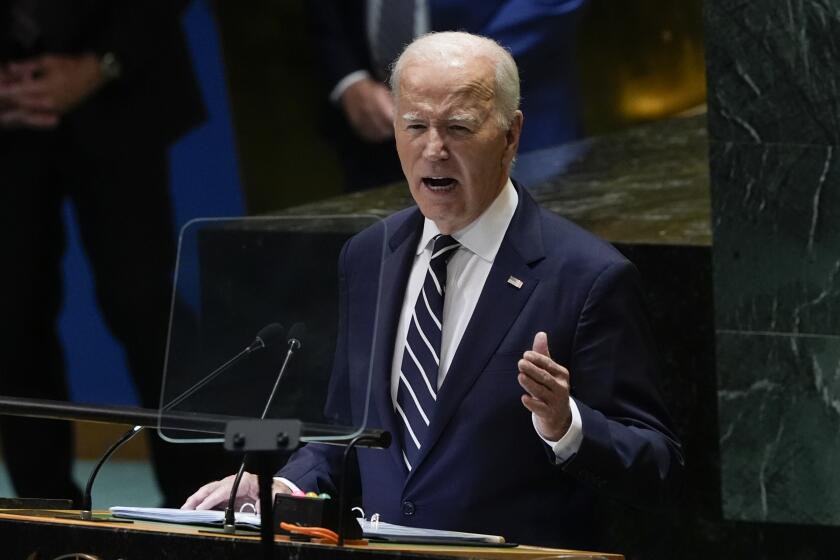New poll boosts Obama in battleground states
Strong support among women and Latinos and doubts about Mitt Romney’s business background have boosted President Obama into a lead in two swing states, according to a poll released Wednesday.
Obama leads Romney among likely voters 51%-45% in Florida and 50%-44% in Ohio, according to the poll by Quinnipiac University, the New York Times and CBS News. The poll also showed Obama with a 53%-42% lead among likely voters in Pennsylvania, a state that some Republicans have touted as a possible swing location. Both campaigns have stopped advertising in Pennsylvania, indicating that neither feels it currently makes the battleground list.
Romney need not win Pennsylvania – a state that Democrats consistently have carried in recent presidential elections. But he probably needs to win both Florida and Ohio to gain election and certainly could not prevail if he lost both states.
The poll continues to show Obama vulnerable – voters still judge him poorly on his handling of the nation’s economy – and in Florida and Ohio, Romney tied him on the question of which candidate would do a better job on that. (Obama had a small lead on that question in Pennsylvania.) Moreover, only about a quarter of likely voters in the three states said that Obama’s economic policies would help their “personal financial situation,” with slightly over a third saying his policies would make no difference and almost 1 in 4 saying they would “hurt.”
Republican strategists have said they believe Romney can use a probable financial advantage in the fall to leverage voters’ discontent with the economy. For now, however, at least in Ohio and Florida, where the campaigns have been battling each other intensively for weeks, the poll indicates Obama has gotten on top of the policy debate and has sown doubts about Romney’s background.
By margins of 58%-37% in Florida, 60%-37% in Ohio and 62%-34% in Pennsylvania, likely voters said they favored Obama’s plan to raise taxes on earnings above $250,000 a year. And asked whether Romney has “the right kind of business experience to get the economy creating jobs again or is Romney’s kind of business experience too focused on making profits” – the argument at the center of the Obama campaign’s advertising barrage against Romney – likely voters in all three states took the president’s side of the case.
In Ohio, likely voters by 50%-41% said Romney’s experience was “too focused on making profits.” In Florida, the divide was closer, 48%-42%, while in Pennsylvania, they split 51%-42%.
In Ohio, the poll showed Obama benefiting from a significant gender gap, with women backing him by a 21-point margin, 58%-37%, while men backed Romney by 10 points, 52%-42%. In Florida, there was little gender difference, but support among Latino likely voters was driving Obama’s margin. He led among Latinos by 56%-37%, offsetting a 42%-55% deficit among whites.
Two other numbers from the poll were good news for Obama’s campaign:
- Among likely voters who side with him, roughly 60% in all three states said they “strongly favor” him. By contrast, among Romney’s likely voters, fewer than 50% said they “strongly favor” their candidate, with the number dropping to 42% in Ohio and 41% in Pennsylvania.
- And when asked about Obama’s economic policies, a majority of likely voters in all three states said either that they “are improving the economy now” or that they haven’t yet, but “will if given more time.”
In both Florida and Ohio, about a quarter of likely voters said Obama’s policies were improving the economy now and 30% said they would in the future. Romney’s strength came overwhelmingly from the likely voters who said Obama’s policies “are not improving the economy and probably never will,” but so far, that group is not enough to win either state -- 43% in Florida and 44% in Ohio.
The poll, conducted July 24-30, surveyed 1,177 likely voters in Florida, with a margin of error of +/-2.9 percentage points, 1,193 in Ohio with a margin of +/-2.8 and 1,168 in Pennsylvania with a margin of +/-2.9. It’s the first survey that Quinnipiac has done this election cycle that focused on likely voters, rather than all registered voters. Typically, the switch from registered voters to likely voters boosts Republican numbers slightly since Republican voters tend to be older and more likely to vote. That was not the case with this survey, however.
Follow Politics Now on Twitter
Twitter: @DavidLauter
More to Read
Get the L.A. Times Politics newsletter
Deeply reported insights into legislation, politics and policy from Sacramento, Washington and beyond. In your inbox three times per week.
You may occasionally receive promotional content from the Los Angeles Times.











